-
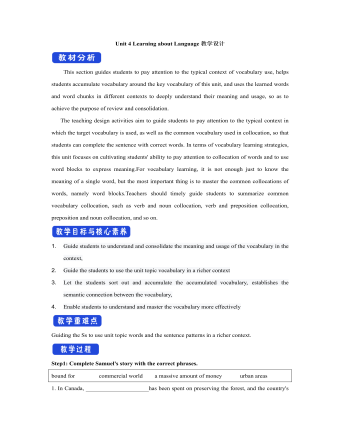
新人教版高中英语选修2Unit 4 Learning about Language教学设计
This section guides students to pay attention to the typical context of vocabulary use, helps students accumulate vocabulary around the key vocabulary of this unit, and uses the learned words and word chunks in different contexts to deeply understand their meaning and usage, so as to achieve the purpose of review and consolidation.The teaching design activities aim to guide students to pay attention to the typical context in which the target vocabulary is used, as well as the common vocabulary used in collocation, so that students can complete the sentence with correct words. In terms of vocabulary learning strategies, this unit focuses on cultivating students' ability to pay attention to collocation of words and to use word blocks to express meaning.For vocabulary learning, it is not enough just to know the meaning of a single word, but the most important thing is to master the common collocations of words, namely word blocks.Teachers should timely guide students to summarize common vocabulary collocation, such as verb and noun collocation, verb and preposition collocation, preposition and noun collocation, and so on.1. Guide students to understand and consolidate the meaning and usage of the vocabulary in the context, 2. Guide the students to use the unit topic vocabulary in a richer context3. Let the students sort out and accumulate the accumulated vocabulary, establishes the semantic connection between the vocabulary,4. Enable students to understand and master the vocabulary more effectivelyGuiding the Ss to use unit topic words and the sentence patterns in a richer context.
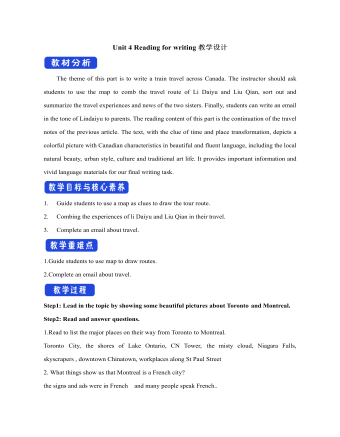
新人教版高中英语选修2Unit 4 Reading for writing教学设计
假定你是英国的Jack,打算来中国旅行,请你给你的中国笔友李华写一封信,要点如下:1.你的旅行计划:北京→泰山→杭州;2.征求建议并询问他是否愿意充当你的导游。注意:1.词数80左右(开头和结尾已给出,不计入总词数);2.可以适当增加细节,以使行文连贯。参考词汇:故宫 the Forbidden City;泰山 Mount TaiDear Li Hua,I'm glad to tell you that 'm going to visit China.First,I am planning to visit Beijing,the capitalof China,where I am looking forward to enjoying the Great Wall,the Forbidden City and somebeautiful parks.Then I intend to go to visit Mount Tai in Shandong Province.I've heard that it is one ofthe most famous mountains in China and I can't wait to enjoy the amazing sunrise there.After that,I amalso going to Hangzhou.It is said that it is a beautiful modern city with breathtaking natural sights,among which the West Lake is a well- known tourist attraction.What do you think of my travel plan? Will you act as my guide? Hope to hear from you soon.

新人教版高中英语选修2Unit 4 Using langauge-Listening教学设计
The theme of the listening section is " talking about scenery and culture along a journey."The part is designed to further lead the students to understand Canadian natural geography and social environment, and integrated into the cultural contrast by mentioning the long train journey from Beijing to Moscow routes. On this basis, the part activates students related travel experience, lets the student serial dialogue, guides the student to explore further the pleasure and meaning of the long journey, and Chinese and foreign cultural comparison.The part also provides a framework for the continuation of the dialogue, which is designed to provide a framework for students to successfully complete their oral expressions, and to incorporate an important trading strategy to end the dialogue naturally.1. Help students to understand and master some common English idioms in the context, and experience the expression effect of English idioms.2. Guide the students to understand the identity of different people in the listening context, and finish the dialogue according to their own experience.3. Instruct the students to use appropriate language to express surprise and curiosity about space and place in the dialogue, and master the oral strategy of ending the dialogue naturally.1. Instruct students to grasp the key information and important details of the dialogue.2. Instruct students to conduct a similar talk on the relevant topic.

新人教版高中英语选修2Unit 5 Learning about Language教学设计
The purpose of this section of vocabulary exercises is to consolidate the key words in the first part of the reading text, let the students write the words according to the English definition, and focus on the detection of the meaning and spelling of the new words. The teaching design includes use English definition to explain words, which is conducive to improving students' interest in vocabulary learning, cultivating their sense of English language and thinking in English, and making students willing to use this method to better grasp the meaning of words, expand their vocabulary, and improve their ability of vocabulary application. Besides, the design offers more context including sentences and short passage for students to practice words flexibly.1. Guide students to understand and consolidate the meaning and usage of the vocabulary in the context, 2. Guide the students to use the unit topic vocabulary in a richer context3. Let the students sort out and accumulate the accumulated vocabulary, establishes the semantic connection between the vocabulary,4. Enable students to understand and master the vocabulary more effectivelyGuiding the Ss to use unit topic words and the sentence patterns in a richer context.Step1: Read the passage about chemical burns and fill in the blanks with the correct forms of the words in the box.
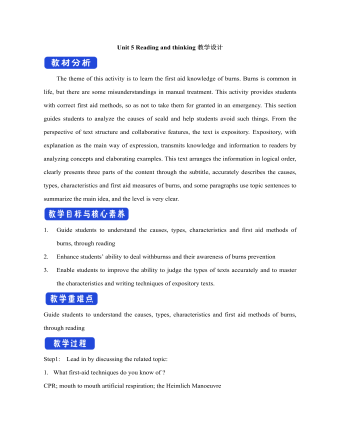
新人教版高中英语选修2Unit 5 Reading and thinking教学设计
The theme of this activity is to learn the first aid knowledge of burns. Burns is common in life, but there are some misunderstandings in manual treatment. This activity provides students with correct first aid methods, so as not to take them for granted in an emergency. This section guides students to analyze the causes of scald and help students avoid such things. From the perspective of text structure and collaborative features, the text is expository. Expository, with explanation as the main way of expression, transmits knowledge and information to readers by analyzing concepts and elaborating examples. This text arranges the information in logical order, clearly presents three parts of the content through the subtitle, accurately describes the causes, types, characteristics and first aid measures of burns, and some paragraphs use topic sentences to summarize the main idea, and the level is very clear.1. Guide students to understand the causes, types, characteristics and first aid methods of burns, through reading2. Enhance students’ ability to deal withburnss and their awareness of burns prevention3. Enable students to improve the ability to judge the types of texts accurately and to master the characteristics and writing techniques of expository texts.Guide students to understand the causes, types, characteristics and first aid methods of burns, through readingStep1: Lead in by discussing the related topic:1. What first-aid techniques do you know of ?CPR; mouth to mouth artificial respiration; the Heimlich Manoeuvre

新人教版高中英语选修2Unit 5 Using langauge-Listening教学设计
The theme of this section is to learn how to make emergency calls. Students should learn how to make emergency calls not only in China, but also in foreign countries in English, so that they can be prepared for future situations outside the home.The emergency telephone number is a vital hotline, which should be the most clear, rapid and effective communication with the acute operator.This section helps students to understand the emergency calls in some countries and the precautions for making emergency calls. Through the study of this section, students can accumulate common expressions and sentence patterns in this context. 1.Help students accumulate emergency telephone numbers in different countries and learn more about first aid2.Guide the students to understand the contents and instructions of the telephone, grasp the characteristics of the emergency telephone and the requirements of the emergency telephone.3.Guide students to understand the first aid instructions of the operators.4.Enable Ss to make simulated emergency calls with their partners in the language they have learned1. Instruct students to grasp the key information and important details of the dialogue.2. Instruct students to conduct a similar talk on the relevant topic.Step1:Look and discuss:Match the pictures below to the medical emergencies, and then discuss the questions in groups.
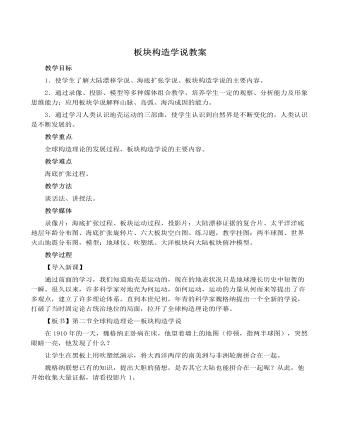
人教版高中地理选修1板块构造学说教案
【启发想象 】能否将刚才讲的内容用一个游泳动作形容一下?这好像蛙泳动作。我们大家一起做:熔岩冒出(双手合十向上)→推向两边(双手向两侧分开)→遇陆俯冲(双手往下)→重熔再生(双手相向合并向上)。【小结板书】二、海底扩张学说前面我们学习了两个假说,整理一下已知条件:事实证明大陆是在漂移的,如欧洲与美洲的距离在扩张,但是漂移的动力不足;海底是不断扩张的,有生长与消亡。能否在前人研究的基础上,提出更准确更合理的假设呢?一个新的理论诞生了,它是目前最盛行、最活跃的全球构造理论【板书】三、板块构造学说1.板块概念学生读书。【启发提问】板块“漂移”与大陆“漂移”的位置有何不同?学生回答。板块漂移是指岩石圈漂在软流层上,大陆漂移发生在地壳两层之间。【提问】板块是如何划分的?读图用半分钟记下六大板块的位置和名称(提示:按大洲和大洋名称记忆)。

人音版小学音乐一年级下铁匠波尔卡说课稿
接受能力强的学生分为一组,让他们互相监督自己练习;接受能力弱的学生分为一组,老师进行个别教育。 通过分组教学得到因材施教的作用。(用传统的跟学法让学生直观地学会边歌曲边表演动作。通过分组教学得到因材施教和学生自主学习的效果。)(四)师生一起边唱边跳互动表演。(通过尽情的表演让学生张扬个性,满足孩子的表演欲望。)(五)课后作业:课后练习边唱《粉刷匠》边跳舞。(让学生学习的内容得到巩固。)(六)课堂延伸和总结 小粉刷匠热爱劳动,不怕脏不拍累,小朋友们向他学习,在学校要主动打扫卫生,在家要积极做自己力所能及的家务活,做一个爱劳动的好孩子。 (延伸课堂内容,提高教学效果。)总之,在这些活动中,更重要的是我们的学生能通过自身的感受、体验而获得情感审美上的升华,提高他们的动作协调性,为热爱音乐、热爱艺术、热爱生活打下良好基础。
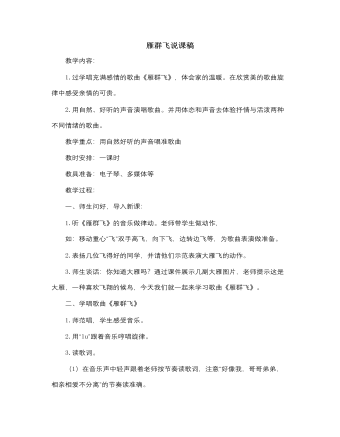
人音版小学音乐一年级下雁群飞说课稿
(1)在音乐声中轻声跟着老师按节奏读歌词,注意“好像我,哥哥弟弟,相亲相爱不分离”的节奏读准确。(2)老师读上半句,学生读下半句。4.逐句教唱,解决难点乐句“飞来飞去不分离”。5.找出旋律相同的两句,用不同的图形或字母表示出来,如:ABA。6.《雁群飞》是一首优美抒情的歌曲,应该用什么样的声音和感情演唱歌曲呢?学生说一说,有感情的演唱歌曲。7.分小组进行简单的动作创编,注意表现出歌曲中的相同与不同。8.学生表演。9.教师与学生一起评一评。三、教师小结。教后记:为了能让学生理解到歌曲的结构,我设问,“歌曲中哪些地方是重复的?”学生经过老师的引导,用笔勾画出了歌曲中重复的乐句。这时我形象地比喻道,它的结构有点像我哦们吃的“肉夹馍”,两边是馍中间有一块好吃的肉,学生一下哈哈大笑起来,还不时地回味说,“真像‘肉夹馍’。”听到这样的回答,我想学生一定对歌曲的结构有了清晰的认识。
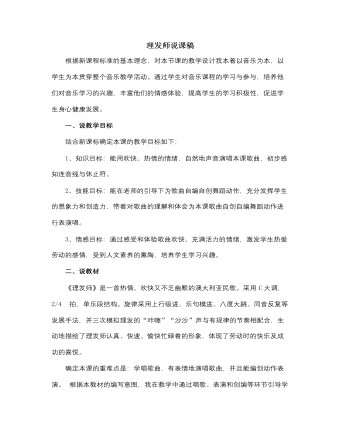
人音版小学音乐一年级下理发师说课稿
第一个部分:让同学们用简单的律动随着音乐跳出三个主题所表达的情绪。让同学们用肢体的律动感受这三种不同的情绪。 第二个部分:通过简单的律动,比较这三个主题情绪的变化和音乐的陈述给律动的感觉带来的不同之处。(五)拓展(想一想):此环节的设立是为了发散学生的思维,能够让学生通过对本作品的欣赏,从侧面了解音乐学科以外的知识,同时,以本曲为音乐背景,也没有脱离本节课的教学内容。(六)小结本课的主旨是“抓住时间”,因此在本课结束时,用一首《明日歌》来收尾,让学生懂得时间宝贵的道理,同时也起到了学科整合的作用。最后让学生听着乐曲走出教室,结束本节课的学习。五、总结在本教学中,我力求让学生以“听和动”为主,开展不同形式引导学生倾听音乐、表现音乐,引导学生从乐曲的旋律、节奏、音色、速度等方面,认知形形色色的钟表形象, 体会人们当时喜悦的心情。

人音版小学音乐一年级下春晓说课稿
1、师分别用慢速、中速和快速演唱歌曲,请学生仔细聆听后说一说三遍演唱的速度和情绪有什么不同。2、排练合唱《春晓》,用慢速和中速演唱歌曲。3、表演节目——大合唱《春晓》。最后简单来说一下反思:音乐教育的最终目的是人的教育,培养人的健康人格、高尚情操、审美能力,而不是把所有的学生培养成音乐家。在我的音乐教学中一直存在着这样一个困惑:老师辛辛苦苦地教学生一遍又一遍唱谱、打节奏、听音程……又叹息孩子的悟性怎么这么差,教了好几遍,总还是似懂非懂。我们是否想过其他的原因呢?孩子是无辜的,他们需要的是音乐的源泉,而非枯燥的乐理、技术;他们需要音乐给予的欢乐,而非畏惧;他们需要活泼开朗、自信的性格,而非怯懦、紧张。所以我认为我们的音乐课中学生要始终在愉快合作、多彩、友爱、融洽的气氛中进行,在不加重学生的任何负担的前提下,让每个学生享受到学习的欢乐。
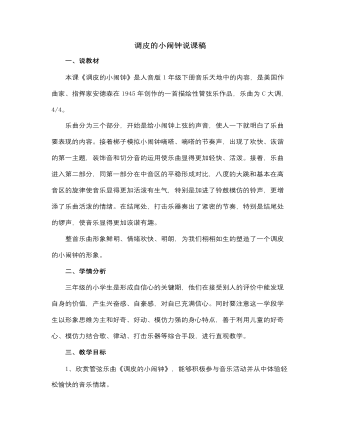
人音版小学音乐一年级下调皮的小闹钟说课稿
首先听A段主题旋律,我启发学生用声势动作、律动等方式参与到音乐中来,让学生展开丰富的想象力,激发学习兴趣进一步感受音乐里调皮的小闹钟形象。然后在通过演唱A段主题旋律,加深对乐曲的主题记忆,为下一环节做铺垫。在B段主题旋律教学中,我引导学生参与音乐体验,引发想象与联想,采用了律动、打击乐器伴奏、声势活动等形式,通过让学生在闹铃声处使用打击乐器伴奏,模仿闹钟铃响参与音乐体验,不断加强学生对音乐主题的理解与记忆更加深了学生对音乐形象的感受,同时也培养了学生的创造力、表现力和良好的合作意识。第四个环节是参与实践,体验音乐有了前面三个环节的“聆听”,接下来就是有拓展地“聆听”。在这一环节不仅体现了学生的表演欲望,同时也锻炼了学生的表演能力。配合多媒体欣赏学生在听音乐主题A、B部分能准确运用律动、歌唱、声势动作、打击乐器伴奏等形式,同时也培养了学生静听音乐的良好习惯,将课堂气氛推向高潮,学生的学习兴趣、自信心、合作能力等都得了很大的提高。
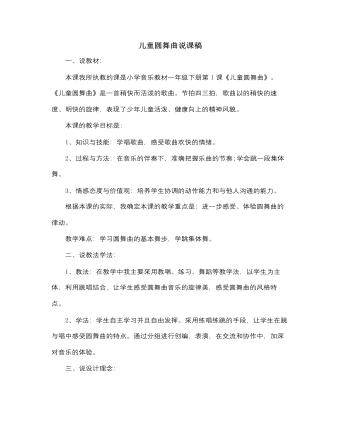
人音版小学音乐一年级下儿童圆舞曲说课稿
本课我采用欣赏《杜鹃圆舞曲》的片断导入新课,挖掘学生已有的对圆舞曲特点的了解,让学生快速进入学习情境,增加学生对圆舞曲学习的兴趣。导入完新课以后,我遵循音乐是听觉的艺术,从聆听入手学唱歌曲,第一次听录音的范唱,让学生聆听音乐,了解歌词的内容。第二次教师有感情的演唱,激发学生听的兴趣,加深学生对歌曲的节拍情绪的理解和感受。在歌曲旋律唱会后,学生自然地就能演唱这首歌曲,知识技能的掌握渗透在歌曲学唱之中。让学生在轻松愉悦的氛围中短时高效的学会歌曲。为了开发学生的创造性潜智,在学会歌曲以后,我设计了舞蹈创编这个教学环节。舞蹈创编就是学生对音乐的再度创作,是发挥学生想象力和思维潜能的学习领域,是学生积累音乐创作经验和发掘创造思维能力的过程和手段,对于培养具有实践能力的创新人才,具有十分重要的意义。让学生的身心、肢体与音乐密切结合,让学生在创编合作中体验快乐,表现快乐。
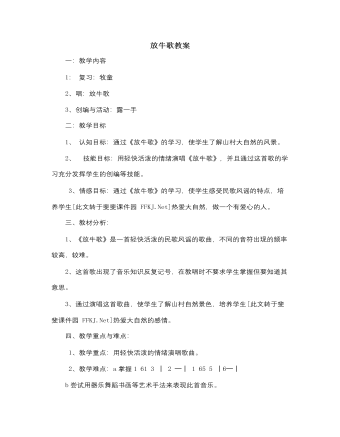
人音版小学音乐一年级下放牛歌教案
你能不能用你的本领把这山村美景表达出来呢? 老师请画画的小朋友在这花丛里,写诗的在小山坡上……….. 四、完美结课: 小朋友玩的高兴吗?好我们一起回家啦!(播放《郊游》)。 教学反思: 启发学生“你都想到了什么?”从而让学生展开丰富的想象,经过教师的简单小结使学生了解了牧童的生活和放牧时的心情,为学唱歌曲《放牛歌》做情感铺垫。 接下来的“体验理解”环节还是以激发学生兴趣为主,从猜小牧童的“宝贝”(笛子)模仿小牧童吹笛子的动作,到学吹笛子的有节奏的嘀嘀声XXXXXX,到有节奏的模仿小黄牛的叫声X-,我都是在让学生从间奏入手的,目的:一是引导学生会听音乐,能听出哪是间奏;二是让学生充分感受歌曲的旋律,熟悉歌曲;三是培养学生[此文转于斐斐课件园 FFKJ.Net]节奏感,知道笛声和小黄牛的叫声表示的节奏是什么,对两个声部的节奏训练进行一次渗透和尝试。
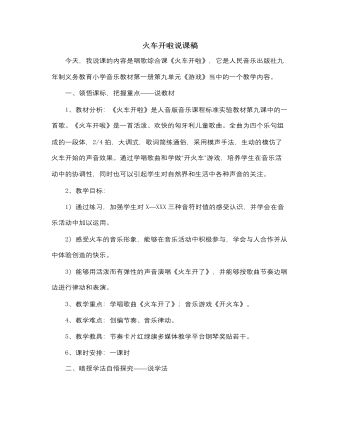
人音版小学音乐一年级下火车开啦说课稿
6、你言我语尽情唱游开火车的唱游对于学生来说是没有什么难度的,我不想手把手的教,而是想让孩子自己摸索出开好火车的方法,于是我说“想把火车开好可不是一件容易的事情,因为火车有好多车厢连在一起,怎么把它连起来?怎么开,我们一起来商量一下。学生有很多方法有的建议拉着前面同学的衣服、搭着前面同学肩膀,我让学生跟我一起来演示,一起研究,大家一起决定什么动作比较好。最后,师生都认同右手搭在前面同学肩膀,左手做车轮滚动的样子。就这样,一列列小火车很快就能够上路了。在唱游过程中,学生不可避免的是相互碰撞,这时停下音乐,宣布:“现在发生了交通意外,请各辆小火车赶快回到自己的位置。”一起讨论怎样才能安全行驶,相互不让路,不喧哗。7、开动火车乐趣无限唱游结束后,我安排了一个游戏:音乐中,两列小火车在教室里自由行驶,音乐停下时到站请旅客上车,音乐开始后继续旅行,直到所有的乘客都上车。这个游戏的设计也是为了让学生体会共同游戏的乐趣,在游戏中学会礼让,安全驾驶。
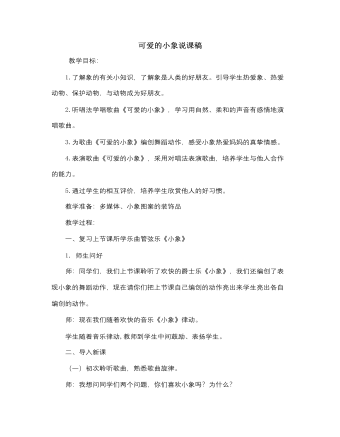
人音版小学音乐一年级下可爱的小象说课稿
师:现在请同学们跟着老师一起朗读歌词。师:我要请两位同学上来,一位同学扮演小朋友,另一位小朋友扮演小象,为我们朗读一次歌词,谁愿意来?学生扮演角色朗读歌词师:你们觉得他们演得好吗?能得多少分?请学生评价,教师总结。(三)编创动作表现歌曲师:如果能加上动作就更好了,现在我们一起来开动脑筋,为这首歌编创动作。在教师的引导下,一句句为歌曲编创动作(四)听唱法学唱歌曲师:我们学会了歌词,还编了动作,当更要学会唱,请同学们跟着老师的琴声学唱歌曲。学生学唱,然后由学生跟着音乐表演歌曲(五)对唱法表演歌曲师:现在我们请1、2组同学扮演小象,3、4组的同学来问小象,我们分角色来表演歌曲。 学生先在原位上演练一遍,然后全体起立,相对而立,表演歌曲。教师作出评价和肯定。三、总结师:今天我们学到了什么学生回答师:今天,我们学习了小象的知识,知道了要与小象成为好朋友,要保护小象和其它动物,学会了表演歌曲《可爱的小象》。
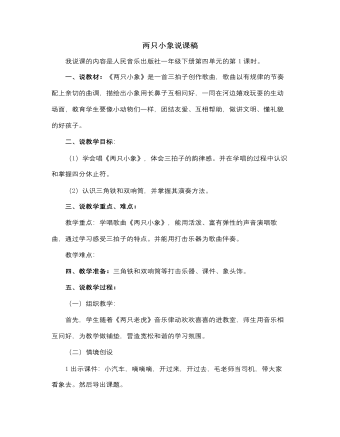
人音版小学音乐一年级下两只小象说课稿
又能再次让学生体会三拍子的韵律感。在配打击乐器为歌曲伴奏这个环节我通过“看图片、找乐器、读节奏、选节奏、敲乐器”等活动充分调动学生学习的积极性,再次掀起学生们的学习乐趣。五、总结:今天我们在动物园和小动物们度过了愉快的一天,我们应爱护小动物,和它们做朋友,而且更要像小动物们一样,团结友爱、互相帮助,做懂礼貌的好孩子。并预告下节课将做象头饰及分小组比赛表演。(在《两只小象》音乐中律动出教室。)总体来说,本方案的设计利用多媒体为学生创设一种生动、直观的教学情景,通过看、听、唱、舞等手段,充分调动了学生的兴趣和积极性,同时在各种音乐活动中,充分体现了学生自主、合作、探究的学习方式,使学生会学、乐学、敢学,将学生自主学习与创新意识的培养落到了实处.

人音版小学音乐一年级下牧童短笛说课稿
该作品是一首带再现的单三部曲式结构,我通过分别播放两段乐曲旋律,引导学生进行对比欣赏,感受两个乐段的旋律的相似之处,充分了解带再现乐曲的主要结构及乐曲情感上的变化特征。第四环节:培养学生创造能力通过分小组合作的形式,为第一乐段的旋律编配合适的舞蹈动作,引导学生充分的感受音乐、欣赏音乐,并且培养学生独立的创造思维与团队的合作意识。第五环节:自评、互评的评价方法该课的教学评价以鼓励和赞赏为主,引导学生在教师的鼓舞下,发挥独立的思维创造能力、培养积极乐观的生活态度与表现能力,主要是通过能否主动的参与小组合作、能否充分表达自己对乐曲的理解,能否主动表达自己对于乐曲的强烈感受等方面来进行评价。以上就是对本课内容的具体阐述,谢谢各位评委老师。以上就是教师招聘《牧童短笛》说课稿,希望能对考生有所帮助。

人音版小学音乐一年级下拍皮球说课稿
多媒体反复播放童声齐唱歌曲《五星红旗》,出示歌谱歌词,画面滚动播放各种五星红旗升起的情景以及运动健儿为国争光的一瞬间。(鼓励学生站起来,可以加上拍手的一些动作跟着音乐边唱边体会歌曲情绪,把课堂推向高潮。)师:小朋友们,当国歌再次奏起,看到冉冉升起的五星红旗,我们的心情是多么的激动,我们一起来呼喊”五星红旗,我们的国旗,我们热爱您”(学生跟着老师一起呼喊)。让我们用自己的歌声来表达我们此时的心情吧。设计意图:通过《五星红旗》的欣赏,升华对祖国的热爱之情。(四)总结下课奥运健儿们的那种顽强的奥运精神,坚强的毅力,都是值得我们小朋友一起学习的,我们就从最简单的拍皮球,跳绳开始吧,好好锻炼身体,将来在各种岗位上为国家争光。
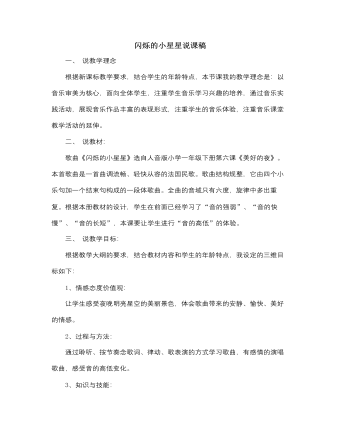
人音版小学音乐一年级下闪烁的小星星说课稿
3、小结:本节课我们听唱了三首不同风格的关于星空的音乐作品,同学们还可以收集更多此类歌曲听一听,感受夜晚星空之美。十、 说板书设计:首先,板书课题时用小星星的图案代替文字,更加吸引学生,容易激发学生的学习兴趣。其次,本节课的板书主要体现乐理知识:反复记号;柯达伊手势图谱。板书目的帮助学生解决学习中的难点。十一、说教学反思:亮点:教师根据学生的身心特点及学习情况有目的、有计划的引导学生进行学习,以达到教学目标。根据学生已有知识,运用柯达伊手势教学法,在准确演唱歌曲的基础上,学唱歌谱,帮助学生建立音高概念,完整的演唱歌曲。成功解决本课教学的难点,完成教学目标。不足之处:教师对于学生律动表演的规则讲解不到位,学生操作不熟练。专业术语使用不到位、不规范,有待于进一步改进和提高。


 QQ登录
QQ登录 微信登录
微信登录